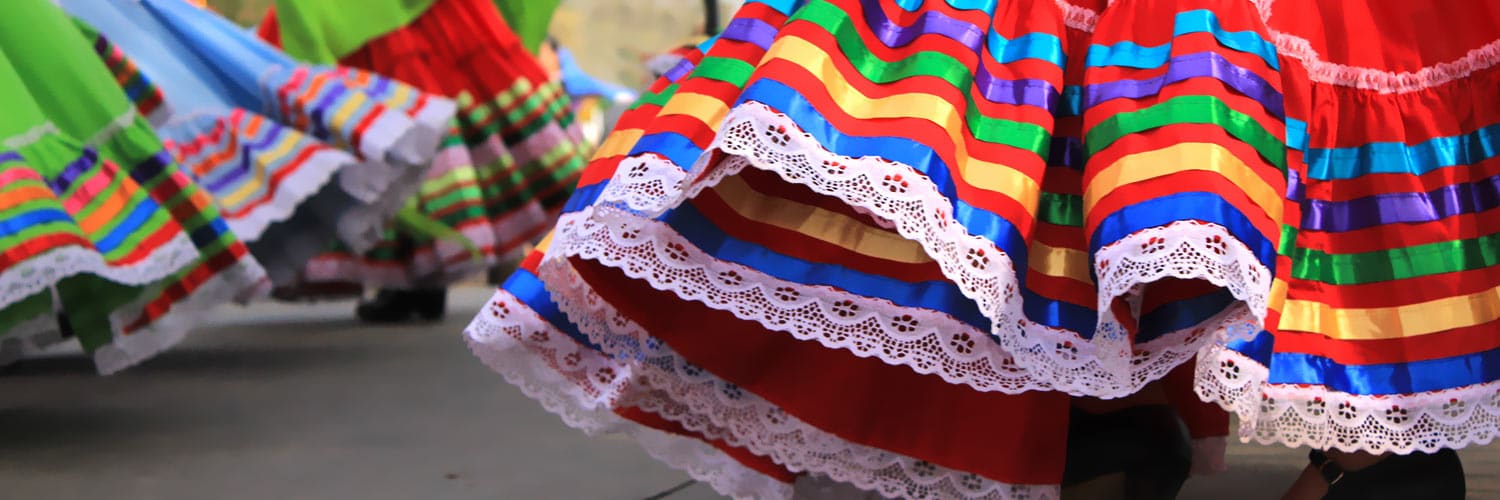Ajijic Loves to Celebrate
With These Annual Events
Tradition, holidays and a strong sense of community are evident in these annual Ajijic events. The holidays in Ajijic are often based on the celebrations of the church. The traditions persist from year to year because of the faithful townspeople who work hard to sustain them. Creating an atmosphere that celebrates life and its various forms of beauty is central to the local culture. The many celebrations held in and around Ajijic are part of the charm of the community. Ajijic events and annual fiestas are known to take over streets with food vendors, carnival rides and handcrafted goods for several days at a time. There are fiestas and holidays every month throughout the year, many with elaborate parades.
Be sure to also view our INN EVENTS PAGE to see what’s happening right here at Casa del Sol!
Mexican Fireworks, Castillos!
Intricate frames known as castillos are constructed with fireworks to form symbols and images. Attached to this hand-made wooden apparatus, the fireworks spin and launch in succession. Live musical performances in the plaza play until early hours of the morning. Families huddle around tables playing games. Skirts swirl stage-front as couples clap and dance to Mexican favorites. The cacophony of sounds and sights creates an intoxicating energy that can be felt. Ajijic has a reputation for being a favorite place to celebrate fiestas andMexicans travel from surrounding villages to share in Ajijic festivities.
Ajijic Events & Celebrations
Ajijic events and holidays in the Lake Chapala area are more frequent after September 16th, when there seems to be something going on every week into the new year. Please double check the dates and times of the events you are interested in, as they vary from year to year.
New Years Festivities – January 1st. One of the more recent additions to the Ajijic events calendar of festivals is a wacky celebration that ends in an afternoon football game between two neighborhoods. The parade usually starts at 1pm at Seís Esquinas in Ajijic and ends at the Tecoluta soccer field. At around 9pm at the Tecoluta soccer field you can see a traditional torito, a bull-shaped fireworks display. People hold it over their heads and run around as it sends out sparks, a popular nighttime tradition during some fiestas in Mexico.
Danza de la Voladores – With deep respect to their heritage, men in traditional dress can often be seen performing on the Malecón. The Danza de la Voladres is a cultural spectacle you will want to see. Men in multi-colored woven garb climb poles up to one hundred and fifty feet tall as one of them plays the flute and drum. Moments of tension lead to the men, voladores, launching themselves off of the spinning platform in synchronization. Attached by ropes, each volador or flier circles the pole thirteen times getting closer and closer to the ground until their heads seem to touch. Folklore tells that the tradition began as a ceremony performed in times of drought, to pray for rain and renewal of the crops.
Fiesta Patronales also known as The Fiestas de San Andrés – From November 20th to 30th, Ajijic holds its biggest fiesta of the year, in honor of its patron saint, Saint Andres. The town celebrates with processions, fireworks castillos, music, amusement rides and other festivities every night in the central plaza. Each night is sponsored by a different organization or group. One night may be the bricklayers, another night may be the gardeners and another the local farmers. Also known as Fiesta de San Andrés, it honors Ajijic’s patron saint. Each town in Mexico has a patron saint and patroness. The days’ sponsors lead with a religious image and launch rockets a hundred feet into the air announcing the parade has begun. Processions occur twice daily depicting biblical scenes that are marched through town ending back at San Andrés Church for afternoon and evening mass. But, you won’t want to miss the nightly festivities. The churchyard is filled shoulder to shoulder with onlookers, as castillos – these unique firework castles are constructed up to four stories tall. The intricate wooden designs involve moving parts and shapes that are lit with fireworks. Some parts are even engineered to propel into the sky off of the castillo. It is unlike anything you have seen or heard before.
Feria de Maestros del Arte – A festival promoting Mexican folk art, is held over three days each November. This important cultural event brings people from all over the world who collect traditional art work. Sponsors pay for the artisans expenses, including transportation, and the artists are hosted by local families. Colorful patterns, geometric shapes and woven flowers take form on traditional garments and contemporary canvases for the festival. For the past eighteen years, the event has brought together an average of one hundred of the top artisans from across Mexico to support and promote Mexican folk art. In efforts to promote the culture to younger generations, talks and sessions highlight ancient techniques and innovative approaches. You will find art crafted in the small towns of Mexico like bruñido pottery and inlaid hand-made knives. For visitors, there’s even a shipping station to make sure your fragile pieces get home safely. The event is held at the Lake Chapala Yacht Club.
Dia de los Muertos – Or, Day of the Dead as it is known North of the border, is one of our favorite celebrations. It takes place the first few days of November each year. This is arguably Mexico’s most famous holiday. Unlike how it is portrayed, it is not Mexico’s version of Halloween. Instead, it is a time to honor life and death mixing indigenous Aztec rituals with Catholic ceremonies inherited from colonial times. Celebrations are held at the town plaza and cemeteries. You’ll find families at the Panteon, the local cemetery, cleaning off old offerings and replacing them with new ones. Objects, food and drink found at altars or ofrendas at grave sites all have significant meaning. Prayers and songs are lifted up to remember friends and family that have passed on. Skeletons and skulls decorate masks, street murals, posters, flags and even candy. But, the vibrant display of yellow and orange marigolds truly characterize the tradition and are used to guide spirits with their bright colors.
Mexican Independence Day – Mexicans memorialize the day they gained independence from Spanish rule annually on September 16th with a Fiestas Patrias. May 5th, or Cinco de Mayo, is not a celebration of Mexican Independence Day although that misconception is widespread throughout North America. The festivities each September begin the night before. Every town’s delegado – mayor of sorts – recites the famous battle cry from 1810 at the same time all over Mexico. As with most festivals, there is an accompanying parade, dancing in the plaza, mariachi bands and more food than needed. At the end of the day, there’s even a traditional combate de flores – a flower fight.
Globos Hot Air Balloon Regatta – Handmade paper balloons fill the Ajijic sky every September heralding the end of summer. Since the 1960s, local businesses and individuals spend weeks constructing these delicate displays made simply of crepe paper and tape, that can tower several stories high. The Regata de Globos is held at the Cruz Azul football field in Ajijic and is free to attend, but donations are encouraged. Hundreds of over-sized and elaborate balloons are launched into the air, from early afternoon into the evening. Some are shaped like coffee cup or animals and others are intricately designed as geometric wonders. Lighting each massive balloon and getting it in the air involves members of each team holding the balloon, lighting the heat source and keeping it aloft until just the right moment. Balloons could catch fire before clearing the field or gracefully travel the entire length of Lake Chapala. It’s quite a spectacle to see!
Carnaval – Seven days of parades are spread out over three weeks of celebrating beginning the day before Ash Wednesday, in Lent. The date depends on the calendar and can be as early as February 3rd and as late as March 9th. It’s a rambunctious festival that is fondly called Mardi Gras in North America. Carnaval in Ajijic has a unique tradition where cross-dressing masked sayacas chase kids through the streets throwing flour at the crowds. Symbolic papier-mâché floats manned by comical masked figures make their way down cobblestone streets to live music played all around them. After the parades, join the luncheon and festivities on the Malecón. In the late afternoon, there is always a rodeo at the lienzo charro.
Mexican Revolution Day – Every November 20th, since 1910, towns in Mexico fill the streets with revelry and parades to commemorate the revolution which lasted ten years. Town folk recreate scenes from the harrowing time before democratization. Young girls dress as adelitas – the heroic women that fought for freedom during the revolution. School groups march in procession carrying depictions of national heroes. In Ajijic, the parade typically begins on Constitución Street, a half-block from Casa del Sol Inn. It lasts for an hour or two before ending at the plaza.
Festival Cultural Sangre Viva – Ajijic celebrates from March 13th to 15th with a three-day festival that promotes Mexico’s indigenous roots. As with most of the world’s native groups, Mexico’s traditions are in danger of being lost forever, and this festival was created to keep them alive. Folk music and dance from pre-Hispanic days will be featured. The festival features performances as well as workshops at Centro Cultural and along the Malecón. You can even take part in a traditional sweat lodge ceremony called a temazcal.
Mexican Chili Cook-Off – This has been temporarily suspended due to the Pandemic.


